The original plan for this trip was to sail from Tollesbury saltings to the Scilly Isles, popping into Fowey on the way to nip across to the Eden Project. After a potter about round the islands, head off back to either Newquay or Falmouth where Miriam, one of the crew, would jump ship in order to get back to an appointment. Then Alan and I would head back to Tollesbury, on the understanding that I would have to jump ship at some point in order to get a flight across to the Brussels Jazz Marathon. Alas, as with all great plans, this wasn't to be. The reasons for the departure from plan will unwind as you read on.
Bad omens appeared soon after we started the journey on the early morning tide, heading down the Orwell estuary on a cold, wet, grey dawn. We were heading back to Tollesbury, the saltings where Alan's boat, Kiitaja, was normally moored, to pick up Miriam Addy, the third crew member. Passing down the Wallet off Walton-on-the-Naze, we received a May-Day from a fishing boat, which we could not see in the mist. The message was broken and muffled but the panic words "engine fire" were mentioned. Once we had the vessel's position from its skipper, we hastened back to the coordinates. We soon got to the vessel and asked the shaken crew if they needed assistance. The fire was by now out but the craft had no engine power. Within the space of ten minutes, three lifeboats turned up, and at the skipper's request, one took the vessel in tow to Titchmarsh marina. It was really heart warming to find that our coast guards are continuously on the ball and could summon ample and prompt help so quickly.
We resumed our journey to Tollesbury, but Alan's concern now was that due to the May-Day diversion, we may miss the window of opportunity to berth at the saltings to collect Miriam. Access to the saltings is normally about an hour each side of high tide, and missing the current tide would mean a twelve hour delay. This became even more complicated when we received a radio call from Miriam, who was at the time sailing back to Tollesbury with her fianc�, stating that their engine, which had been working intermittently, had now died altogether. We caught up with them and gave them a tow to their berth.
After we had dropped Miriam's boat off at her berth, Alan quickly headed into his berth for the collection of Miriam plus the extra provisions she was bringing. The tide was by now ebbing, and time was of the essence. Just as Kiitaja was entering its berth, a sudden gust of wind pushed her away from the staging, ripping out a bow mooring post and causing a stern line to become entangled around the prop, stopping the engine dead. We were now going nowhere until this was untangled; some brave soul had to get into the muddy water and under the stern to untangle the rope. Making matters worse, with the tide now on the turn, there wasn't much water between the stern and the thick stinking mud that forms the bed of the saltings. Never having experienced such pleasures of swimming in mud, I volunteered to venture below into the murky waters. I stripped down to swimming shorts and waded into the icy cold muddy water. The only way to access the prop was to get completely under the water, and since visibility was almost nil, the rope had to be untangled by feel. It took a few attempts, but the mission was eventually completed. We just managed to slip the berth in what must have been centimeters of water to spare. The voyage resumed, and it already seemed to have been a long day.
As we headed down to North Foreland the wind picked up enabling a good close-haul sail. Our journey was interrupted by the mizzen sail falling down; the halyard had snapped, so we continued our sail under genoa and main. The wind direction was unfavourably on the nose, so we had to resort to engine power, and with strong winds forecast, we decided to seek shelter in Ramsgate. After a little bobbing about outside Ramsgate waiting for a ferry to enter the harbour, we put in around 01:00, found a spare mooring on a jetty, and settled down for the night.
Ramsgate
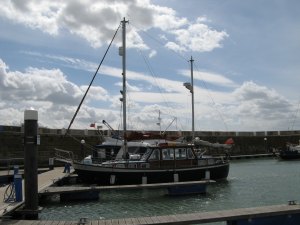 Kiitaja moored in Ramsgate marina |
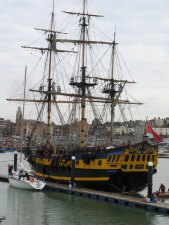 The Grand Turk in Ramsgate marina |
Dover
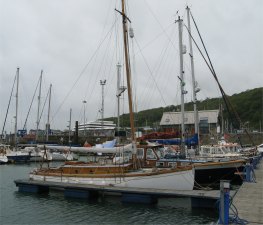 Nancy Blackett moored in Dover marina |
We found that by pure chance we were moored next to the Nancy Blackett. Nancy Blackett is one of the boats once owned by Arthur Ransome, author of the "Swallows and Amazons" books, and appears in "We Didn't Mean to Go to Sea". Recently rescued and restored, Nancy Blackett is now preserved and maintained by the Nancy Blackett Trust, and is regularly on show at maritime festivals, as well as sailing hundreds of miles each year, crewed by Trust members.
The weather was now deteriorating which was rather concerning. We came across other crews who were also concerned about the worsening conditions. One crew who were trying to get their boat across to Ireland had decided to leave their boat in Dover and fly there instead. Another crew hoping to reach Scotland also decided to opt for an early alternate transport mode.
Since we were going to be cooped up in Dover for a while with winds Force 6-7, occasionally gusting to 8, we decided to make the most of it. Alan had mentioned to me that one of the windscreen wiper motors was throwing out sparks when it was switched on. I stripped it down, cleaned out the commutator segments, reassembled it, and that cured the problem. However, all the mechanisms were seizing up on the external side of the screen, so we dismantled all the exterior parts, cleaned them and applied liberal coatings of WD40 and oil, and they all seemed to function well after reassembly.
We also used this dead time to improve our culinary skills; I quite enjoy cooking for a group of people. Cooking on board a boat presents its own challenges. When at sea, particularly if it is rough, it may end up as an exercise in trying to open cans whilst jamming oneself on the floor in a kneeling position. Such joys are increased multifold when trying to extract pots and pans out of the small locker under the stove; everything spills out. I have a problem trying to cook below decks in rough weather since lack of a horizon to focus on can make me seasick. However, in calmer waters, cooking on board can be a pleasurable experience. Since Miriam was vegetarian, the majority of meals had that bias, though she was a sport and occasionally cooked us a non-vegetarian meal. Miriam and I both enjoyed cooking; Alan definitely sees cooking as a chore, though he will occasionally indulge. I can imagine him on one of his solo sails pulling out cans on a lucky dip basis and creating a magnificent concoction. I did try and instill a sense of healthy eating on ship, and earned the reputation as the "health police".
Alan was keeping busy running his software business from the wheelhouse. He was fortunately, or unfortunately, a lynch pin for a few companies' systems software, and his services and advice were in constant demand. Miriam, who was involved in an organisation supplying teaching services to Burma, was also constantly emailing to oil the wheels of the organisation. I just oiled anything that moved.
 A View Inside Dover Castle |
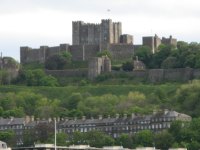 Dover Castle |
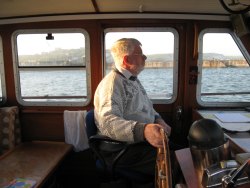 Alan Heading out of Dover Not Knowing What to Expect |
 The White Cliffs of Dover from Inside the Harbour |
Brighton
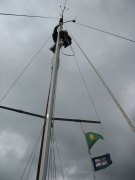 Alan Trying to Repair the Anemometer in Brighton |
Our two days in Brighton were not all fun though. Alan was hoisted up the main mast to try and repair the anemometer. It was a bitterly cold, wet day, and after about three hours the poor lad came down frozen. I can't remember exactly why but great difficulty was had hoisting Alan up the mast. Two winch handles were snapped in the process! We also had problems below decks. Periodically, Kiitaja's alternator would stop charging due to the fan belt slipping. So, periodically, we would take up the floors to access the engine and tighten the belt.
By now, we had abandoned all hope of getting back on track to our original plan, and options were being discussed. The forecast was for gradually decreasing winds over the next few days, with the Inshore Forecast for Force 4-5 decreasing, with slight or moderate sea state. Can these guys ever get it right? We decided to make a break for it and head west along the south coast to see how far we could get. With this in mind, we slipped out of Brighton at 09:00 the following morning.
Bembridge, Isle of Wight
We took a battering on the journey west, winds were Force 6-7, and it was like riding a relentless roller-coaster. Indeed it was so rough that the planks on the pulpit were being ripped off by the seas. Alan spent some time on his stomach at the bow in rough water lashing them back down with rope as a temporary measure till proper repairs could be effected. By the following morning with no sign of the foul weather abating, we diverted to the Isle of Wight and sought safe haven in Bembridge marina on the eastern point of the island
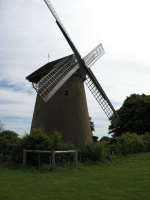 Bembridge Windmill |
 Lord Yarborough Monument |
The story of the man the monument is dedicated to is very interesting. Lord Yarborough's summer residence was Appledurcombe, and, after his family, his first love was the sea. Lord Yarborough's most famous ship was the 'Falcon', a full-rigged ship reported to look like a twenty gun ship-of-war, which was launched in June 1826. Discipline was very strict and ran on Royal Navy lines; he even got his crew to sign a paper volunteering to be flogged if the need arose! They were paid an extra shilling a week for agreeing, although by all accounts, due to Lord Yarborough's character it is unlikely that this ever took place.
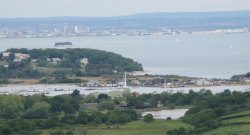 View across Bembridge, St Helens and the Solent to Portsmouth |
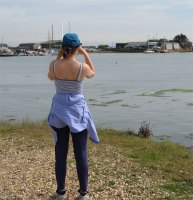 Miriam Taking a Final Snap |
The following day we secured all the planks on the ships pulpit. The time had also come for Miriam to jump ship. It was a shame, she was good company and a source of inspiration in cooking and Scrabble exercises. She was also leaving at a time when the winds were starting to improve - slightly. I took the opportunity to do some more exploring, and succeeded in dragging Alan out to St Helens for a drink in the afternoon, and we spoiled ourselves that evening by having a meal at the marina club house.
The next day I had an enjoyable walk along the coast to Ryde in glorious sunshine; the experience of rough seas seemed so far away. During my return, I got a call from Alan; the marina was filling up rapidly with serious rafting of craft taking place to accommodate the large number of vessels. Apparently they have rafted up to seven vessels deep at times. We had to get out quickly before we were trapped in. When I got back there was by now a raft in front and another behind us. Getting out in the strong tide with a Force 6 pushing us onto the pontoon was going to be tricky, and crews from the rafts before and aft of us were getting paranoid that we may damage their craft in the escape attempt. Fortunately Alan is an experienced skipper and using his version of a Highwayman's hitch on a line to midships, got us out without a scrape. The onlooking sailing fraternity were gob smacked at how we managed this. We spent the night anchored outside Bembridge happily in calmer seas. The following day we leisurely watched a dinghy race deciding what to do next. A plan was hatched to sail round the Isle of Wight and drop me off at Gosport; I needed to get back for my Brussels trip.
 Sunset Over the Marina |
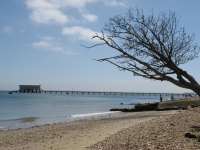 Bembridge Lifeboat House |
 Tall Ship at Anchor off Bembridge |
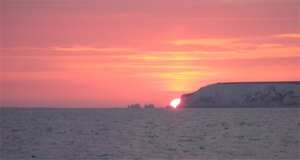 Sunset Over the Needles |
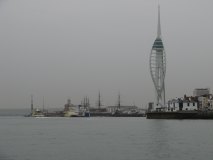 The Spinnaker Building, Portsmouth |
Despite all the vagaries of the weather and complete destruction of the original plan, this was a most enjoyable and memorable trip. The company was congenial, and like most of Alan's trips, peppered with a variety of hazards, hardships, surprises and most importantly, fun. I get a lot of pleasure from these sailing adventures; long may they continue.
